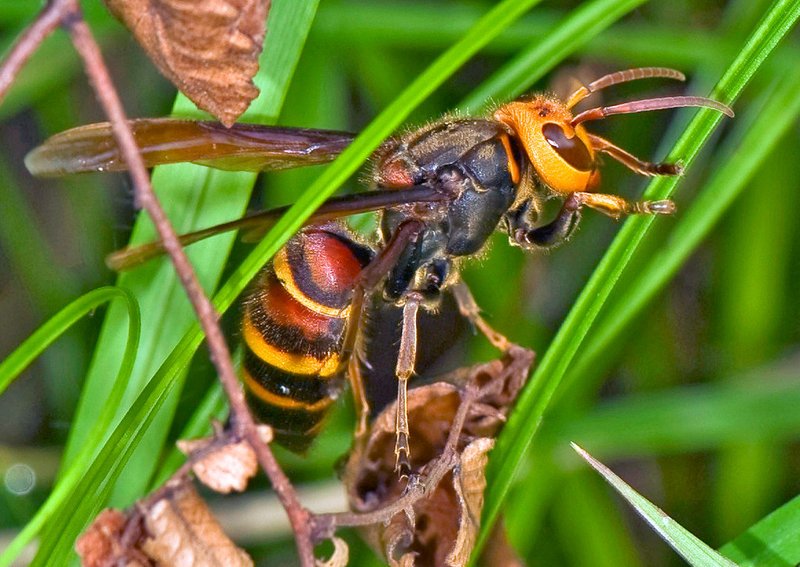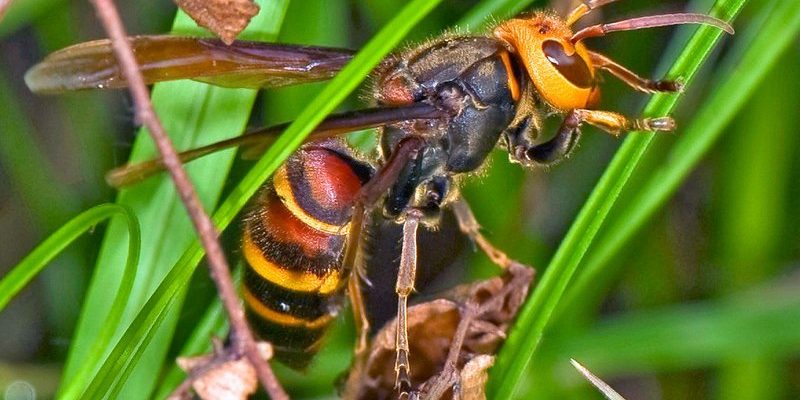
When you think about large insects, the Giant Hornet might come to mind. This creature is not just big by insect standards; it’s a powerful force of nature. Imagine a hornet the size of your thumb, buzzing through the air with a distinct hum. It’s both intriguing and a bit intimidating, especially if you’re not familiar with it. These insects, known scientifically as Vespa mandarinia, have gained attention around the world, particularly for their size and behaviors.
We often hear fascinating stories about them, from their impressive nests to their role in ecosystems. If you’re curious about what makes the Giant Hornet tick—or fly, rather—buckle up. You’re about to dive into the world of this extraordinary insect, where we’ll explore everything from its behavior to its diet, and even how you can safely coexist with them if you encounter one.
What is a Giant Hornet?
The Giant Hornet is the largest species of hornet in the world, boasting a body length of up to 2 inches. Can you believe that? These insects are striking with their bold yellow and black markings. However, beyond their appearance, there’s a lot more to know. Originating from East Asia, they are now found in various parts of the world, often in temperate regions. They have a distinctive reputation for their aggressive nature, especially when their nests are threatened.
What’s fascinating is their social structure. Like other hornets, Giant Hornets live in colonies with a queen, worker hornets, and males. The queen lays eggs and manages the colony, while the workers gather food and protect the nest. This collective effort makes them efficient survivors, and their formidable size adds to their edge against potential threats.
Physical Characteristics
So, what exactly does a Giant Hornet look like? These insects are not just oversized; they have unique features that set them apart. They have a large head equipped with powerful mandibles. These jaws are incredibly strong, capable of delivering a painful sting. Their wings can span over three inches, allowing them to fly swiftly and maneuver easily, which is part of what makes them such effective hunters.
Interestingly, the Giant Hornet’s coloration plays a role in their survival. The bold yellow and black pattern isn’t just for show; it serves as a warning to potential predators. Their size and color can deter animals that might otherwise take them on. This combination of features makes them not only fascinating to observe but also remarkable in their roles within the ecosystem.
Habitat and Distribution
The Giant Hornet thrives in diverse environments, preferring wooded areas, fields, and gardens. They typically build their nests in trees or shrubs, using paper-like material they create by chewing wood mixed with saliva. These nests can be quite massive, sometimes housing thousands of hornets. Imagine discovering a structure the size of a basketball, tucked away in the branches of a tree!
Originally native to East Asia, these hornets have expanded their range, now appearing in parts of Europe and North America as well. Their presence in new territories can lead to concern because they can disrupt local ecosystems and compete with native species. Understanding their preferred habitats is crucial for anyone interested in observing or studying these fascinating insects.
Diet and Hunting Behavior
Giant Hornets are predominantly carnivorous. Their diet mainly consists of other insects, particularly honeybees. This predatory behavior can be alarming for beekeepers, as the hornets can decimate bee colonies in a short period. When they hunt, Giant Hornets display remarkable coordination. They will often scout for prey, returning to the nest to share the location with fellow workers, who then band together for a swift attack.
While they are formidable predators, their diet is not limited to other insects. They also consume sugary substances, like nectar or fruit juices, that provide them with essential energy. You might find them hovering around flowering plants, looking for the next snack. It’s a fascinating look into their adaptability as they balance between being hunters and scavengers.
Reproduction and Life Cycle
The life cycle of a Giant Hornet is as intriguing as the insect itself. It begins in the spring when the queen emerges from hibernation to establish a new colony. After finding a suitable site, she lays her eggs and tends to the initial brood, which will grow into worker hornets. Once those workers mature, they take over the responsibilities of foraging and expanding the nest.
As summer approaches, the colony reaches its peak. It’s during this time that you’ll notice an increase in their activity. The workers focus on gathering food and defending the nest against threats. However, as fall arrives, the queen shifts her focus to reproduction. New queens are produced, while workers begin to die off as the weather cools. This cycle persists, with new colonies emerging each spring, continuing the process.
Human Interaction and Safety
Encountering a Giant Hornet can be unnerving, especially if you’re unfamiliar with them. They are not naturally aggressive, but they will defend their nests vigorously. If you find yourself near a Giant Hornet nest, remember to remain calm and avoid sudden movements. It’s best to leave them alone, as they play important roles in their ecosystems.
In case you do get stung, it’s essential to treat the site promptly. While their venom is potent, it’s rarely lethal to healthy adults. However, for those who are allergic, a sting can be much more serious. Always keep an eye on your symptoms, and seek medical attention if you experience unusual reactions.
Giant Hornet vs. Other Hornets
You might be curious about how the Giant Hornet stacks up against its smaller cousins. For one, the Giant Hornet is significantly larger than typical hornet species, which can make a big difference in their behavior and hunting strategies. While other hornets may be more passive, the Giant Hornet’s aggressive nature is more pronounced, particularly when defending their nests.
Additionally, their diet is more predatory compared to many smaller hornets, which may feed on a broader range of substances. The size and power of their stings also set them apart. When it comes to size, there’s simply no contest; the Giant Hornet commands attention and respect in the insect world.
Interesting Facts About Giant Hornets
Let’s take a moment to delve into some unique facts about Giant Hornets that might surprise you. Did you know that a group of Giant Hornets can consume approximately 50 bees in just one day? That’s a staggering number! Their ability to take down entire hives in such a short span highlights their hunting prowess.
Another interesting tidbit is how their nests can be mistaken for a round ball of paper. From a distance, they can look harmless, but getting closer reveals the bustling activity of these insects within. Their nests are often built high off the ground, which also provides them with a strategic advantage against predators and humans alike.
| Characteristic | Details |
| Size | Up to 2 inches long |
| Wingspan | Up to 3 inches |
| Habitat | Forests, fields, gardens |
| Diet | Insects (especially honeybees) and sugary substances |
| Lifespan | Workers: up to a few months, Queens: 1 year |
| Aggression | High when defending their nest |
In the end, the Giant Hornet is a marvel of nature. Its strength, complex social structure, and hunting abilities make it a standout among insects. While they can pose risks, understanding these creatures helps us appreciate their role in the ecosystem. Whether you encounter one while hiking or simply want to learn more, there’s much to respect and admire about the Giant Hornet.
FAQ
Are Giant Hornets dangerous to humans?
While Giant Hornets are not typically aggressive, they can become dangerous if their nests are threatened. Their venom can cause painful stings that might lead to allergic reactions in some individuals. It’s best to admire these insects from a safe distance.
How can I identify a Giant Hornet?
The Giant Hornet is distinguishable by its size—up to 2 inches long—and its striking yellow and black coloration. Its large head and powerful mandibles also make it easily recognizable compared to smaller hornets.
What should I do if I get stung by a Giant Hornet?
If stung, wash the area with soap and water, apply ice to reduce swelling, and take an antihistamine if needed. Monitor for any severe reactions and seek medical help if necessary, especially if you have known allergies.
Do Giant Hornets only live in specific places?
Giant Hornets prefer wooded areas, fields, and gardens. Originally from East Asia, they have expanded their range into Europe and North America, adapting well to various temperate habitats.
Why do Giant Hornets attack honeybee colonies?
Giant Hornets are carnivorous and primarily hunt honeybees for protein to feed their colony. They can quickly overwhelm a bee colony, leading to significant losses for beekeepers.
Can Giant Hornets survive in cold climates?
While they prefer temperate climates, Giant Hornets can survive in cold areas by hibernating during winter. The queen will emerge in spring to start a new colony.
How long do Giant Hornets live?
The lifespan varies by role; workers may live for a few months, while queens can survive for about one year, depending on environmental conditions and threats.
How do Giant Hornets build their nests?
Giant Hornets construct nests by chewing wood into a pulp mixed with saliva, which they shape into paper-like structures. These nests can be quite large and are often built high in trees or shrubs.
Are Giant Hornets social insects?
Yes, Giant Hornets are social insects that live in colonies. Each colony includes a queen, workers, and males, all working together to ensure the colony’s survival and growth.
What do Giant Hornets eat besides bees?
In addition to hunting insects, Giant Hornets consume sugary substances like nectar and fruit juices, which provide essential energy. They are opportunistic feeders and adapt their diet based on available resources.
How many Giant Hornets are in a colony?
A colony of Giant Hornets can contain thousands of individuals, especially at its peak during the summer months when worker hornets are most active.
Can Giant Hornets be beneficial to the environment?
Yes, despite their intimidating nature, Giant Hornets play a role in controlling pest populations, particularly harmful insects. They also contribute to the pollination of various plants, highlighting their ecological importance.

